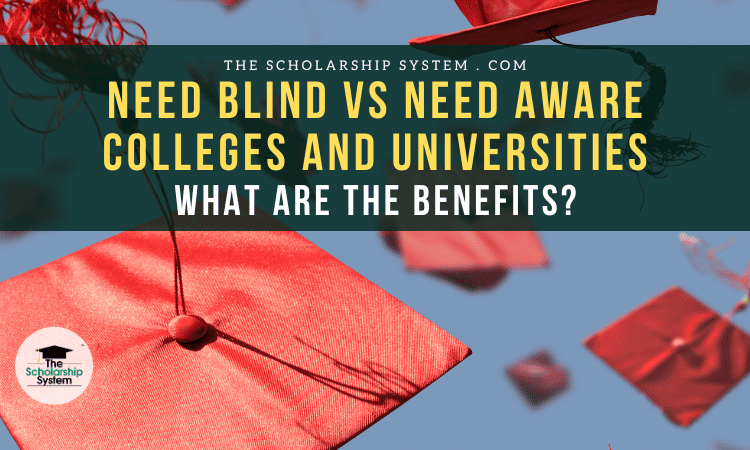Updated on March 29th, 2024
When it comes to college admissions, the terms “need-blind” and “need-aware” pop up quite often, sparking a myriad of conversations and debates among students and parents alike. On the one hand, need-blind colleges assess applications without considering the financial situation of applicants, promising an admissions process that solely focuses on academic and extracurricular merits. Need-aware institutions take a peek into the financial aid section of applications, which can influence the final admissions decision.
For student who want to make any school more affordable, scholarships are an excellent way to cover the cost their education. If you and your student want to learn about college scholarships, sign up for our free college scholarship webinar! Take a quick trip over to http://thescholarshipsystem.com/freewebinar to reserve a spot today.
Understanding the nuances of need-blind vs need-aware colleges is crucial for students as they navigate the complex landscape of college admissions and financial aid. If you’d like to learn more about how the two stand apart, here’s a closer look at the need-blind vs need-aware admission process and financial aid packages.
Defining Need Blind vs Need Aware Colleges and Universities
What Is Need-Blind Admissions?
Need-blind admissions is like the college admissions version of a blind taste test – the folks reviewing your application have no idea what’s in your wallet. Need-blind schools make their admit-or-deny decisions without so much as a glance at your student’s financial situation. This means your student’s ability to pay tuition doesn’t sway their judgment on whether they get that coveted acceptance letter.
For students sweating over the gap between their expected family contribution and the total cost of college, this approach is a sigh of relief. It’s all about grades, extracurriculars, and that personal essay your student spent weeks perfecting. And if they’re one of the lucky admitted students, these institutions often pledge to meet 100% of their full demonstrated financial need, cobbling together a financial aid package that can include grants, loans, and a bit of merit-based aid to make their college dreams financially feasible.
What Is Need Aware Admissions?
On the flip side, need-aware admissions is like going on a date where the other person knows exactly how much is in your bank account – a bit uncomfortable, right? When colleges take this route, they peek at your student’s financial need while deciding if they’ll be among the accepted students.
It’s not that they’re heartless or only after the money; these institutions are just trying to balance the books, making sure they can offer enough support to the students they’ve already welcomed aboard. While the term ‘need-aware’ might make you think it’s all about the dollars, these colleges still care deeply about who students are and what they bring to the table. The main difference is that your student’s financial situation gets a seat at the decision-making table, potentially influencing the final call. While it might seem like these schools aren’t prepared to help students with limited funding, many of these colleges offer robust financial aid packages that aim to meet a significant portion of a student’s demonstrated financial need.
Difference Between Need Blind and Need Aware Admissions
Imagine your student is at a fork in the college admissions road: one path is lined with need-blind schools, where their talent is the only ticket they need, and the other path is dotted with need-aware colleges, where their financial backdrop might tweak the storyline. The core difference lies in whether a student’s ability to pay gets a backstage pass during the admissions process.
Need-blind institutions are like those elite, prestigious colleges that pride themselves on crafting a diverse tapestry of students purely based on what they can achieve, not what they can pay. They’re the dream-makers, often ensuring that every dime of demonstrated financial need is covered, from tuition down to textbooks.
Need-aware colleges, while sometimes viewed as the more pragmatic players, juggle the delicate balance of building a talented class and keeping their financial health in check. They, too, can be prestigious, offering substantial aid but with a keen eye on ensuring the numbers add up. Whether need-blind or need-aware, each approach has its merits, painting a picture of the diverse landscape of higher education financing.
How Many Need-Blind Universities Are in the USA?
In total, there are only a little more than 100 entirely need-blind colleges and universities in the United States. However, for international students, most of the schools that are need-blind for domestic students are need-aware of international ones. Overall, there are only around five need-blind schools when it comes to international student admission, making need-aware colleges more common for them.
Types of Need Blind Financial Aid Policies
Navigating the landscape of financial aid can feel like trying to find your way through a maze, especially when your student is eyeing a need-blind school that promises not to peek at their bank account during the admissions process. These institutions come with a variety of financial aid policies designed to ensure that students’ ability to pay tuition doesn’t hold them back from achieving their academic dreams.
From colleges that pledge to meet all your demonstrated financial needs without loans to those that include loans as part of the package, understanding the types of need-blind financial aid policies can help you plan how you’ll manage to pay tuition costs and other expenses. Here’s a closer look at the various policies.
Full Need, No Loan Colleges
Imagine a college that looks at your financial aid application, nods, and says, “We’ve got you covered” – and they mean it, and all without adding loans into the mix. These colleges aim to make education accessible to all, ensuring that a student’s ability to pay tuition isn’t a barrier to entry. As a result, need-blind schools are like the superheroes of the financial aid world. They commit to covering every penny of an admitted student’s demonstrated need, primarily through grants and scholarships.
This means that barring any personal expenses outside the typical cost of attendance, students won’t have to worry about paying back a mountain of debt after graduation. However, it’s worth noting that this golden ticket is often reserved for domestic students, with international or transfer students sometimes finding themselves outside the no-loan bubble.
Full Need with Loans Universities
Next, there are the institutions that say, “We’ll help you cover the costs, but there’s a catch.” These need-blind universities also commit to meeting the full demonstrated financial need of their students, but their financial aid packages might include federal student aid in the form of loans. It’s not necessarily a bad deal, especially considering that loans can be manageable and come with relatively low interest rates, especially the subsidized ones for students with significant financial need.
Ultimately, these universities strive to balance offering substantial need-based aid while also acknowledging the reality of their financial constraints. For students, this means that while they might have to take on some debt to pay tuition costs, the amount is calculated with their financial aid needs and expected post-graduation earning potential in mind, aiming to keep the debt as low and manageable as possible.
Financial Aid Not Guaranteed Colleges
In the diverse ecosystem of need-blind admission policies, some colleges operate with a bit more caution. These institutions maintain their commitment not to consider an applicant’s ability to pay tuition during the admissions process, but they stop short of promising to meet 100 percent of every admitted student’s demonstrated need.
This approach doesn’t mean these colleges throw financial caution to the wind; instead, they offer a range of financial aid packages based on what they can afford, which might cover a significant portion of a student’s financial needs but not the whole amount. In the end, it’s a mixed bag, with some students receiving generous aid packages that nearly cover all their costs, while others might find gaps that need to be filled with private loans, work-study, or other forms of aid.
Typically, these colleges are incredibly upfront about their financial aid policy. Additionally, they actively encourage students to carefully consider all potential costs and resources before making a decision, ensuring students make the right move based on their financial situation.
Pros and Cons of Need Blind Universities
Diving into the world of need-blind universities is like opening a treasure chest; you’re bound to find some glittering pros along with a few rusty cons. On the shiny side, these institutions evaluate your application without letting your bank account throw its weight around. This means every admitted student’s demonstrated financial need takes center stage only after they’ve been accepted, ensuring a fair shot for everyone.
Many schools that offer need-blind admissions also come with the promise of robust financial assistance, making the goal of attending a prestigious university not just a pipe dream for students from all walks of life, including U.S. citizens, permanent residents, and often international or transfer students. It’s all about keeping the admission gates wide open, basing decisions on talent and not the thickness of a student’s wallet.
However, every coin has two sides, and need-blind policies are no exception. While the idea is noble, the execution can sometimes lead to a pile-up of student debt. Since financial aid applications are reviewed separately, there’s a chance the full demonstrated need might not be met for everyone, especially when the pot of gold for financial aid isn’t bottomless. This can leave some students scrambling to cover the gap, either through loans or outside scholarships.
Plus, while many schools boast need-blind admissions, the reality is that the list isn’t endless, especially when looking at options for international or transfer students. So, while need-blind universities open doors and level the playing field, students might still need to navigate the tricky terrain of financing their education, demonstrating financial savvy alongside their academic prowess.
Pros and Cons of Need Aware Colleges
Need aware colleges, like a well-meaning but nosy relative, take a peek into your financial status while making their admissions decisions. The upside? These institutions are like the master chefs of college admissions, carefully balancing the ingredients to ensure they have enough dough to provide sufficient aid to those who make it through the gates.
This approach can be particularly reassuring for students who make the cut, as it often means the college is confident in its ability to support them through their tuition costs. For many colleges, this model is a pragmatic choice, ensuring a diverse student body while keeping the lights on and the financial aid flowing, especially for domestic students, and sometimes even extending a helping hand to international applicants.
On the flip side, the need-aware policy might make some students feel like they’re walking on economic eggshells. Low-income students or those from middle-class backgrounds might worry that their financial status could be the tie-breaker in a close admissions decision. This can lead to a bit of a cat-and-mouse game, where applicants try to guess how much their economic status will sway admissions officers.
Additionally, while many colleges strive to be as generous as possible, the reality is that not every institution can promise to meet 100 percent of the demonstrated need for all admitted students. So, while need-aware colleges aim to keep their communities vibrant and their finances in check, the approach can sometimes introduce an extra layer of stress for applicants concerned about how their financial situation might color their admissions outcome.
Colleges with Need Blind Admissions Policies
Students are often interested in knowing which universities have a need-blind policy. Ultimately, many prestigious private schools are on the list, but there are others that don’t factor need into their admission decision. Here is a list of schools that use a need-blind admissions policy:
- Amherst College
- Boston College
- Brown University
- California Institute of Technology (Caltech)
- Carnegie Mellon University
- Columbia University
- Cornell University
- Dartmouth College
- Duke University
- Georgetown University
- Harvard University
- Johns Hopkins University
- Massachusetts Institute of Technology (MIT)
- New York University (NYU)
- Penn State
- Pomona College
- Princeton University
- Stanford University
- University of Chicago
- Yale University
Universities with Need Aware Admissions Policies
For students who think need-based scholarships are a necessary part of their education equation, there are plenty of need-aware colleges to explore. Here is a list of some of the universities that factor a family’s finances into the equation when evaluating applicants:
- Auburn University
- Bates College
- Bryn Mawr College
- Carleton College
- Clemson University
- Colgate University
- Loyola Marymount University
- Northeastern University
- Smith College
- Tufts University
- Washington University in St. Louis
- Wesleyan University
Is Need Blind or Need Aware Admissions Better?
So, when it comes down to the showdown between need-blind and need-aware admissions, which one takes the trophy? Well, it’s kind of like asking if pineapple belongs on pizza—it really depends on who you ask!
Both policies have their champions and their critics, especially in the face of rising costs and the quest to land a spot at a dream school. Need-blind might win hearts for its “judge me by my achievements, not my bank account” vibe, while need-aware gets a nod for its “keeping it real with the finances” approach.
At the end of the day, the best fit varies from student to student, depending on their circumstances, priorities, and, of course, where they see themselves thriving. The key is to keep your eyes on the prize and remember that, regardless of the policy, your worth isn’t measured by tuition costs but by the dreams and determination you bring to the table.
For student who want to make any school more affordable, scholarships are an excellent way to cover the cost their education. If you and your student want to learn about college scholarships, sign up for our free college scholarship webinar! Take a quick trip over to http://thescholarshipsystem.com/freewebinar to reserve a spot today.









Leave a Reply